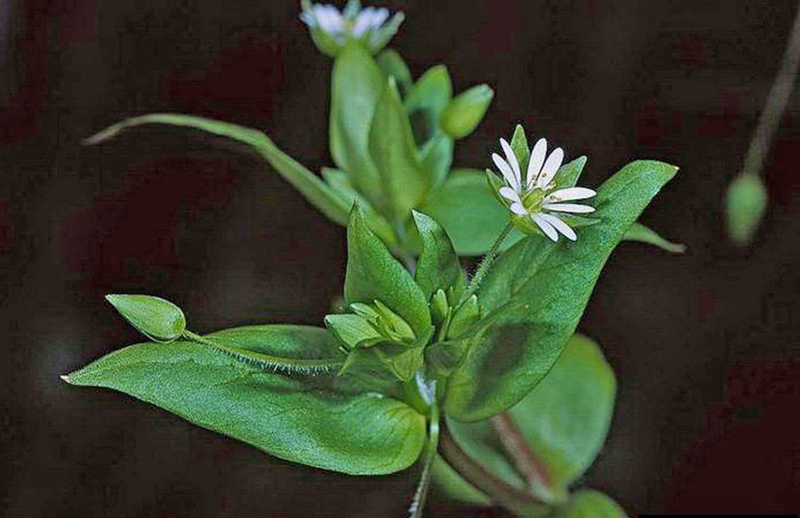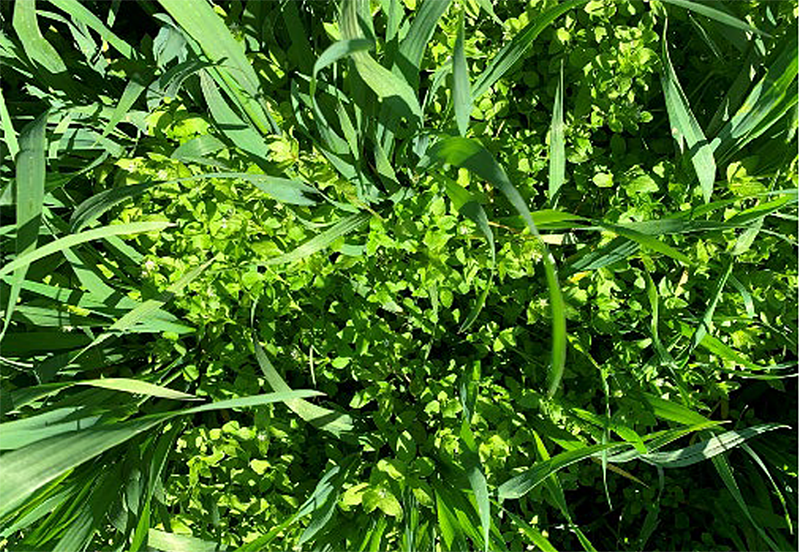Varied solutions eyed for chickweed in small grains

Researchers at the University of California and California State University, Fresno, say an integrated approach is needed to control common chickweed, a widespread and invasive weed that impacts grain fields such as wheat or triticale. The challenge for growers in the southern San Joaquin Valley region is the species is resistant to popular herbicides.
Photo/Vicky Boyd


Photo/Joseph M. DiTomaso/University of California, Davis

Photo/Nick Clark/University of California Cooperative Extension
By Vicky Boyd
Although researchers have confirmed that common chickweed in California is resistant to popular herbicides that target the enzyme acetolactate synthase, or ALS, they say that doesn’t necessarily mean eliminating use of them.
Weed experts recommend growers and pest control advisors take an integrated approach that includes identifying resident weed species and, if needed, applying a herbicide tank mix that includes at least two different effective modes of action for weed control for small grain crops such as wheat or triticale.
“If you notice that ALS inhibitors are not controlling common chickweed, you need to look at other chemistries to control it,” said Nick Clark, University of California Cooperative Extension agronomy farm advisor for Kings, Tulare and Fresno counties. “If you have a whole ecosystem out there and you know ALS herbicides still smoke four of the five weeds, you keep them in the tank and add something you know will get the chickweed.”
The issue appears to be localized in the southern San Joaquin Valley. Clark said he has talked to colleagues in the northern San Joaquin Valley and Sacramento Valley, and they say ALS herbicides continue to work well.
The problem came to light in 2021 when a few pest control advisors alerted Clark about possible ALS failures to control common chickweed in wheat and triticale fields. They had ruled out potential application errors or poor environmental conditions.
This led Clark, fellow UCCE farm advisor José Dias and UCCE weed specialist Brad Hanson to conduct trials in a field with documented escapes and with two ALS herbicides.
Two and four times the labeled rate of one herbicide only slightly reduced common chickweed populations, while two and four times the labeled rate of the other had virtually no effect on the weed compared to the untreated check.
Clark enlisted the help of Anil Shrestha, a weed science professor at California State University, Fresno, to conduct formal greenhouse tests to confirm their suspicions. Joining them was Fresno State graduate student Jennifer Valdez-Herrera.
They verified that the samples of common chickweed found in southern San Joaquin Valley small grain fields were resistant to three ALS herbicides. These were tribenuron methyl, the active ingredient in Express Herbicide with TotalSol soluble granules; pyroxsulam, the active ingredient in Simplicity CA; and mesosulfuron-methyl, the active ingredient in Osprey.
Brian Gogue, a PCA with Helena Agri-Enterprises in Hanford, said he saw the greenhouse trial results, and they were “pretty cut and dry.”
“That explained a lot,” said Gogue, who was one of the PCAs who had brought the issue to Clark’s attention.
The researchers are evaluating two additional ALS herbicides. While the results are still preliminary, Clark said they appear very similar to previous tests.
As part of her master’s thesis, Valdez-Herrera is working with Fresno State professor Katherine Waselkov, a plant evolutionary geneticist, to study possible genetic changes within common chickweed as causes for resistance.
Clark said several questions remain, including what type of economic impact the weed poses to small grain producers, particularly under heavy infestations. He said he hoped to share research results soon to help growers and PCAs make more informed crop management decisions. Clark said he could envision growers eventually incorporating preplant burn-down options or preplant herbicides registered for small grains into south valley weed management practices.
Currently, the most common weed- management system involves one post-emergent application targeting in-season weeds.
The Weed Science Society of America tracks herbicide resistance in specific weeds, and most of the cases in the country involve ALS inhibitors. Based on the data, Clark said he wasn’t surprised they found ALS-resistant common chickweed in the southern San Joaquin Valley since it had already been confirmed in at least five other states and several other countries.
“I was surprised it had taken so long for us in California given that it has occurred in so many other wheat-producing areas in North America,” he said. “It wasn’t welcome, but it was expected.”
Clark pointed to changing field crop production trends as a possible reason for resistance development. During at least the past 10 years, double-cropping that involved winter small grains followed by dairy forage has become popular in the southern San Joaquin Valley.
With that in mind, growers were limited in the herbicides they could use in small grains because some carried plant-back restrictions, which required lengthy waiting periods before corn could be planted. Because many ALS herbicides do not have those requirements and can be used on a wide variety of crops without any waiting, they were used widely, he added.
“There’s continually less crop diversity on the forage ground, so there’s been more intensive use on dairy ground of herbicides, and ALS inhibitors in particular,” Clark said. “It’s a ubiquitous group of chemicals that are used on just about every crop. It’s possible to go from one crop to another and still have an ALS on one crop to the next.”
In the past, Gogue said, phenoxy herbicides such as 2,4-D were commonly used in small grains, but they were not effective on common chickweed. The ensuing registration of Express herbicide, followed a few years later by Simplicity, provided “lights out” control of chickweed, he added.
“The adoption of those new (ALS) herbicides was very quick and very strong because of chickweed,” he said. “It was absolutely amazing what they did, and it was what we needed.”
The confirmation of chickweed resistance has prompted PCAs like Gogue to change their weed management recommendations, but he said it’s difficult because there aren’t many other good options.
Gogue said he also has seen the effectiveness of ALS herbicides on some of the other broadleaf and grassy weeds they formerly controlled.
Herbicide resistance occurs when a single mode of action is used repeatedly on a pest. No herbicide is 100% effective, and a small number of individuals survive treatment because of a slight difference in genetic makeup. Those survivors may reproduce. With continued use of the same mode of action, the number of resistant plants in the population may increase to the point that the herbicide is no longer effective.
(Vicky Boyd is a reporter in Modesto. She may be contacted at vlboyd@att.net.)




